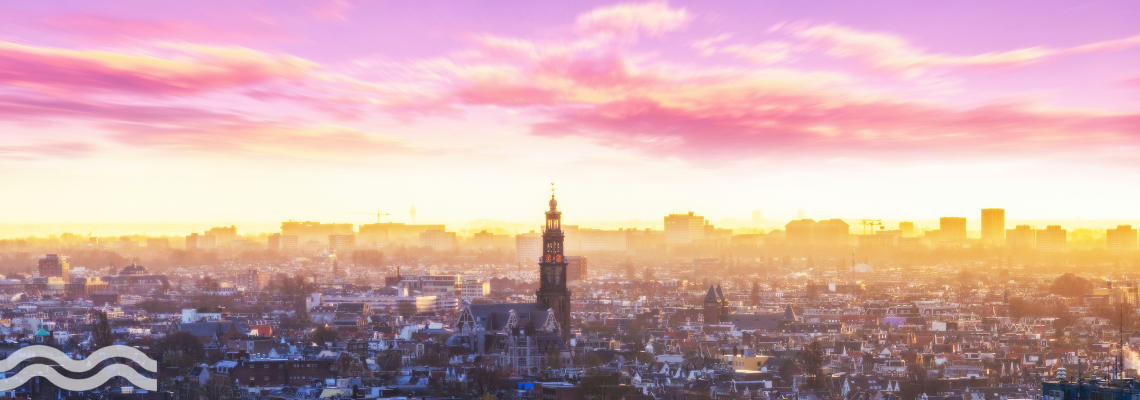Blue/green roofs: solving four urban problems in one solution

Blue-green roofs have the potential to solve four urban problems in one go: increased water collection and reuse; sustainable energy production; building insulation and thriving eco-systems.
What to do with roof space in urban environments
The potential uses for rooftops in urban environments tend to fall into a number of categories. Often, they are simply roof spaces, perhaps with telecoms aerials. Sometimes, they are utilised for solar panels to make the most of their lofty position, providing a green energy source to the buildings they sit atop.
Green roofs have also grown in popularity in recent years. These roofs are planted with various grasses and plants that require little water to thrive. Their benefits include: rainwater absorption, insulation, air purification, wildlife habitats, aesthetics and helping to lower urban heat.
Green roofs have many benefits, but their potential to cool buildings and urban environments is limited by the plants that are suited to the environment.
When choosing a sustainability option for an urban roof, however, a choice often needs to be made between PV panels (energy production) and a green roof (water absorption, insulation). However, things might be about to change; a project in Mannoury. Amsterdam has brought together architects, city planners, research departments and technology companies* to develop a blue/green roof that combines PV panels, water reuse/irrigation and vegetation.
Blue-green roofs – providing energy while cooling the city
The research and development project installed in Mannoury is providing the stakeholder companies with valuable data concerning the viability of blue-green roofs for future development.
The integrated solution is known as Urban Photosynthesis; the work builds on the earlier Smartroof 2.0 project, which among other things, proved the excellent insulation qualities of a blue/green roof.
In the future, no rainwater and rooftop should be left unused.
Permavoid’s Rozanne van Vliet told Aquatech Online: “We feel that stormwater is a valuable resource that we should cherish and reuse for healthy urban areas. We believe circular water management solutions are the key to climate resilient cities worldwide, so we hope this project demonstrates the various ways we can (and should) use rooftops.
“It’s not either/or, but both/and solar panels and a roof garden stimulating biodiversity. In the future, no rainwater and rooftop should be left unused,” Van Vliet added.
The way it works

Schematic representation of Urban Photosynthesis, with the reuse of shower water, its treatment on the roof and use for the vegetation, as well as PV panels on top of the vegetation.
Van Vliet explains: “This system stores valuable stormwater and automatically transports it back to the soil via capillary irrigation so the plants can use it for evaporation. This in turn cools the environment of the solar panels, which makes them more efficient.”
Typical green roofs rely solely on rainwater to nourish grasses and plants. Once the water is gone, any irrigation comes from sources including potable water. However, if a system can convert grey wastewater from the building into irrigation water, this can be used to maintain a green roof even through drought.
The result is something we can all work with and really is a solution that provides us with the benefits cities all around the world need.
At Mannoury, the greywater comes from showers taken by residents. The water is fed to a drainage and retention layer under the vegetation on the roof, where it is treated. Therefore, treatment is integrated into the blue/green roof itself.
The water and the greenery provide much more of a cooling effect on the building than traditional green roofs. The system potentially allows a greater variety of plants to be grown, which may have even greater cooling effects.
Another benefit is the almost constant evaporation from the plants, which will provide a cooling effect on the PV panels, therefore increasing their efficiency.
It is possible that one further effect will be that less space is needed for PV panels which will free roof space for more greenery, water collection, terrace space or for some other innovation.
The challenges for blue/green roofs
The Mannoury project will help to supply answers to many of the questions and challenges regarding the potential for wider use of blue/green roods in urban environments.
There are questions over whether there will enough greywater available to make the roofs viable without having to revert to groundwater or potable water.
Then there is the question of how and where to treat the greywater; at Mannoury, greywater is collected from residents’ shower water and treated in a thin substate beneath the vegetation. Different roof spaces in other environments might need alternative solutions to these problems.
Blue/green roofs have global potential
With little room in cities for water reuse, collection and storage, and the need to improve sustainability, including the use of renewable energy, blue/green roofs may have the potential to overcome the either/or conundrum of choosing PV panels or a green roof, while helping to keep buildings cool.
The project has brought together research departments, technology companies, architects and city planners to design and develop something that Van Vliet believes has great potential.
“The result is something we can all work with and really is a solution that provides us with the benefits cities all around the world need,” Van Vliet added.
*Project stakeholders included: Permavoid, the city of Amsterdam, TKI Watertechnologie, Aedes Real Estate, Drain Products Europe, ECOFYT, Gemeente Amsterdam, KWR, Techniplan Adviseurs and SDR electrotechniek.


